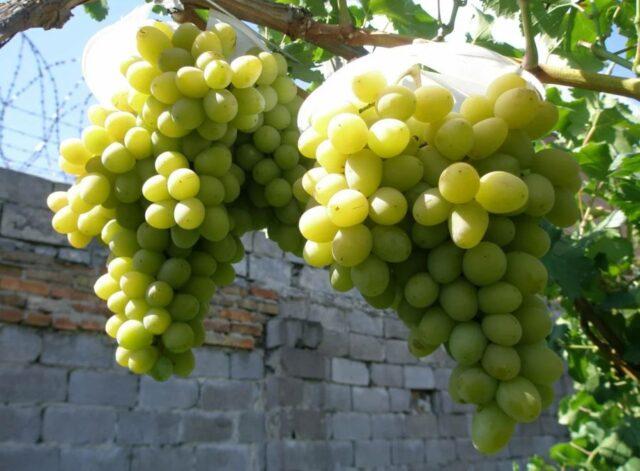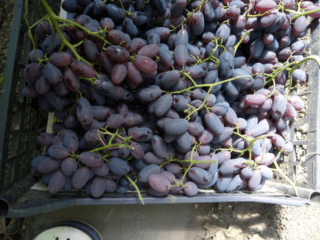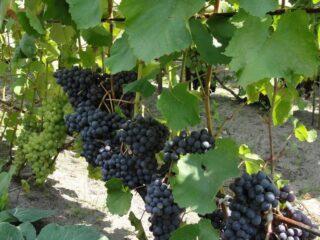Muscat grape varieties are especially popular due to their high sugar content. There are many productive and easy to grow varieties of the crop.
What grapes are called muscat?
Muscats are a group of grape varieties that share common characteristics. The varieties are characterized by:
- high sugar content combined with acidity from 19 to 33%;
- characteristic aroma with a tart musky note;
- high yield and large fruit;
- good phytoncidal properties.
The homeland of muscat grapes is Central Asia, but currently varieties of this group are grown in France and Italy, Spain and Crimea. There are table varieties intended for consumption as dessert, and technical varieties - they are used in making wine.
The best Muscat grape varieties
It is recommended to grow muscat grapes in warm regions with a lot of sunny days. Despite this, there are both particularly heat-loving and relatively cold-resistant hybrid varieties.
Hamburg
The grape variety of English origin produces round or oval small berries weighing no more than 4 g in weight with 2-3 seeds. The nutmeg pulp is juicy, the skin is black with a waxy coating, and hard. The shoots of the variety are first green and then turn red-brown; the leaves are five-lobed and heart-shaped.
Hamburg muscadine grapes bear fruit in large conical clusters up to 20 cm in length. Ripens in an average of 148 days and ripens by the end of September. The berries have good shelf life and can be stored for up to three months without loss of commercial properties. At the same time, the fruits do not stay on the branches for long and quickly fall off.

Hamburg muscat grapes freeze severely at temperatures below -19 °C
The disadvantages of Hamburg Muscat include low immunity. Grapes often suffer from bacterial canker, mildew and oidium, gray rot, and are affected by root aphids. It is especially difficult to grow the crop in heavy acidified soils with high humidity levels. Hamburg grapes require constant antifungal treatments and careful monitoring by the gardener.
Under favorable conditions, the variety demonstrates high productivity and allows you to collect up to 120 centners of fruits from 1 hectare of plantings. But in cold and rainy summers, the figures drop significantly.
Muscat Blau
The Swiss grape variety with muscat taste is a cold-resistant variety and can withstand temperatures as low as -29 ° C. Ripens in 135-140 days, produces large loose clusters up to 300 g in weight.The berries of the variety are black, round, up to 5 g, with several seeds inside.
Muscat Blau has good immunity to fungi, but often suffers from wasps, so it is better to cover the bushes with fine mesh. Requires regular pruning and fertilizing. Despite its high frost resistance, it is intended for cultivation in the south, since in the northern regions the variety lacks sunlight.

Muscat Blau grapes are suitable for table use and for making homemade wine.
Muscat pink
Pink nutmeg is grown in Italy and France, as well as in the south of Russia, Tajikistan and Kazakhstan, Azerbaijan and Armenia. The variety has medium-sized, slowly developing bushes with reddish shoots and slightly pubescent leaves. Ripens in 140 days.
Brings cylindrical dense clusters up to 200 g, consisting of dark pink round berries with a pronounced waxy coating. As it ripens, it almost turns black; the pulp of the variety is juicy with a strong musky aroma. Pink nutmeg acquires its best taste at temperatures above 29 °C. Therefore, grapes grown in a temperate climate, even with quality care, are not as sweet as those from the south.

Pink muscat is characterized by good ripening of shoots - barren vines occupy no more than 25% of the total volume
Pleven nutmeg
The Bulgarian early variety of muscat grapes reaches maturity in 115 days. Large conical clusters of up to 600 g each are formed on the shoots. The berries themselves are also quite large - up to 8 g, at the beginning of ripening they are green, and under the sun they acquire a bright yellow color. The pulp of the variety is crispy, sweet in taste, with a weak aroma.
Pleven grape bushes reach 2 m in height, the variety takes root easily and propagates well by grafting. It ripens evenly and during the growing process requires regular pruning by 6-8 buds to maintain the yield and size of the berries. Due to its high sweetness, it attracts wasps, so it is recommended to protect grapes from insects using nets.

Pleven muscat grapes can be harvested from the beginning of August
Muscat summer
Early ripening Muscat grapes of Moldavian origin fully ripen in 120 days. It grows up to 3 m, produces cylindrical-conical clusters weighing from 650 g to 1 kg. The grape berries are long, oval, yellowish-white or amber in color, weighing on average no more than 8 g.
Summer muscat is characterized by good ripening of the vine - up to 80%. This feature guarantees an annual bountiful harvest in favorable sunny weather. The variety belongs to the medium frost-resistant category, but at temperatures below -23 ° C it still requires shelter. Has good immunity to downy mildew.

Summer nutmeg in the south can be harvested from the first days of August
Muscat Donskoy
One of the oldest varieties of muscat grapes is most often used in making wine. The variety is distinguished by early ripening, taking an average of 115 days, and produces fairly compact clusters of up to 200 g in weight. The berries of the variety are black, round in shape, weighing only about 2 g, with aromatic juicy pulp.
The grapes do not crumble or crack for a long time, and develop well in any soil.Don Muscat tolerates cold temperatures down to -30 °C and is suitable for growing in regions with frosty winters and short, sunny summers.

Fruiting vines of the Don Muscat occupy about 50% of the total number of branches
Muscat super red
A hybrid variety with average frost resistance tolerates unfavorable weather conditions. It has bright green leaves and red shoots and bears berries just 95-100 days after the ovaries form. The variety can be grown in temperate climates, where there are not as many sunny days a year as in the south.
The fruits of the super-red variety of muscat are round or oval in shape, with scarlet, almost purple skin after final ripening. The berries are collected in clusters of regular cylindrical shape, 300-400 g each. The variety has a relatively low sugar content of 18-20%, therefore it rarely suffers from wasps and other insects, which is its important advantage.
The harvest of the Superred variety is stored for a long time, does not rot or crack, so grapes can be grown for transportation and sale. Muscat is often used to make dry and sweet wines. The advantages of the variety include high immunity to gray rot and other fungi. At the same time, mildew and oidium still pose a danger to grapes, so regular preventive spraying is necessary for bushes.

Ultra-red early nutmeg can be harvested as early as July
Muscat Livadia
Ukrainian early variety with loose clusters of 500-800 g produces yellow-green elongated berries with 1-3 small seeds. It is characterized by high productivity; in warm summers it ripens by the end of July.It tolerates drought well and does not freeze at temperatures down to -21 ° C, and rarely suffers from fungi and pests. The skin of the berries is dense, so the crop is not affected by wasps. The shoots of the variety ripen well, but need pruning to 4-6 buds.
It is convenient to grow Livadia grapes on the site due to the compact size of the bushes. The variety is not tall, does not require pollination, rarely thickens and almost does not need to be formed. It grows well on loamy and sandy soils, but with proper care it can grow on almost any soil.
The sugar content of Livadia nutmeg berries is relatively low - about 19%. This allows the variety to be used both for table purposes and for the production of alcoholic beverages.

The taste of the Livadia variety greatly depends on the weather - in cold, rainy summers the grapes become sour
Muscat novoshakhtinsky
A hybrid Russian variety with large clusters of 400 g each ripens in approximately 115 days. Produces large round berries of purple-red color up to 10 g, the fruit pulp is juicy, crunchy, with a nutmeg-caramel flavor.
The Novoshakhtinskaya variety has a thin skin, but the grapes are not prone to cracking. Tolerates moderate winter frosts down to -24 °C, demonstrates good shelf life and is suitable for transportation. But the grapes’ disease resistance is low; in particular, the variety often suffers from black rot.

Novoshakhtinsky nutmeg bears fruit abundantly, but its ripening is uneven
Russian muscat
The domestic Muscat table grape variety for the Central Black Earth region has fast-growing shoots and green or grayish leaves. The clusters are small, on average up to 130 g in weight.The fruits of the variety are greenish-yellow with an amber tint, the pulp is very juicy in taste and aromatic.
Russian muscat requires shelter at temperatures below -22 ° C, is not affected by mildew, but suffers from powdery mildew and gray rot. The disadvantage of this variety is its tendency to crack. Grapes are rarely grown for transportation; they are recommended to be consumed fresh immediately after harvest.

Russian muscat reaches full ripeness in 120 days
Noble
A white Muscat grape variety of hybrid origin with conical clusters up to 600 g produces very large berries. Some of them can reach 18 g in weight. The fruits of the variety are ovoid, with thin but dense white skin. Frost resistance of grapes is average - down to -23 ° C, so it is better to grow bushes in the southern regions.

Noble nutmeg ripens in an average of 115 days
Muscat Moscow
Muscat grape variety for the south of Russia and the middle zone grows on average up to 1.8 m. It develops quickly, has large leaves with weak pubescence at the base. Bears fruit clusters of medium weight, cylindrical-conical in shape.
The Moscow Muscat berries are light green. Inside, the fruits are sweet, juicy and crunchy, with 2-3 small seeds. When grown in the sun, Moscow nutmeg acquires a yellowish tint. The skin of the berries is dense, but thin. Ripening occurs on average in 3.5-4 months, the sweetness of the fruit is determined, among other things, by weather conditions and the amount of sunlight.
Moscow nutmeg is suitable for growing in temperate climates, although it requires shelter when the temperature drops to -25 °C or more. Prefers sunny areas and does not bear fruit in the shade.Rarely suffers from fungal infections, but requires treatment for spider mites and other insects. It prefers loose and acidic soils, although in the absence of waterlogging it can successfully develop on almost any soil.

The sugar content of Moscow Muscat is on average 17.5%; a slight sourness is felt in the taste
Far Eastern
A hybrid variety of muscat grapes was bred by breeders from Primorye. The plant's yield is average, but the clusters are very small - only about 80 g each. The clusters are usually conical, less often branched, individual berries are round and slightly flattened, with whitish-yellow skin and a pleasant sweet taste. The weight of the fruit is 1.5-2 g, the sugar content is at the level of 24%.

Far Eastern muscat ripens by mid-summer and is suitable for cultivation in the northern regions
Muscat Dievsky
One of the best muscat grape varieties for wine and table use is characterized by good vine ripening and high survival rate of cuttings. It has medium-sized bushes and large leaves with slight dissection, and fully ripens within 120 days.
The brushes of the Dievsky variety are large, up to 800 g in weight, moderately loose. The berries are very large, oval with white or yellowish dense skin, up to 20 g. They are characterized by a harmonious taste and high juiciness, suitable for fresh consumption and for making homemade wine.
Dievsky muscat easily withstands cold temperatures down to -23 C, tolerates drought and high humidity, and develops well in all types of soil.In general, it demonstrates good productivity, although in rainy seasons it may decrease. The variety's susceptibility to fungi and pests is average; with regular preventive treatments, grapes rarely suffer from diseases and insects.
When growing Dievsky nutmeg, you need to pay attention to trimmings. The variety bears fruit quite abundantly, resulting in the vines being overloaded. Before the harvest begins to ripen, it is recommended to shorten them, otherwise the berries will not reach their maximum size and will turn out to be small.

Dievsky nutmeg, under favorable weather conditions, is harvested in mid-August
Khrustinka
Hybrid muscat grapes belong to the table group of varieties and produce medium-sized clusters weighing up to 600 g. The fruits are large and weighty, up to 16 g, elongated in shape with rounded tips. The skin of the grapes is red-violet, the berries are beautiful and do not turn black when ripe.
The fruit tastes sweet with a musky note, juicy and crunchy. They remain on the branches for a long time and do not fall off, crack or rot. Khrustinka grapes are suitable for long-term transportation; the harvest can be stored at low temperatures for three months.

When grown in the south, Muscat Khrustinka can produce clusters weighing more than 1 kg
Conclusion
Muscat grape varieties are considered elite due to their particularly sweet taste and unusual tart aroma. They are distinguished by good fruiting, but have high demands on growing conditions. Even frost-resistant varieties need plenty of heat and sunlight.








